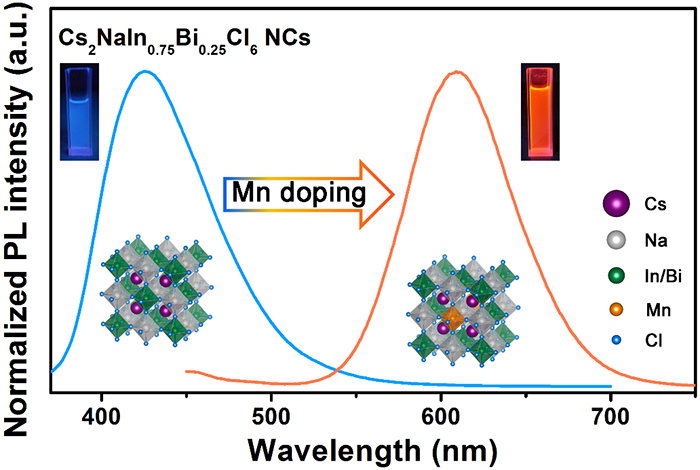A research team led by HAN Keli from the Dalian Institute of Chemical Physics (DICP) of the Chinese Academy of Sciences successfully synthesized undoped and Mn-doped lead-free double perovskite (DP) nanocrystals (NCs). Undoped NCs exhibit blue emission, while doping Mn2+ ions realize bright orange red emission and the dynamics mechanism was further studied. The results were published in ACS Cent.Sci.
Lead-free halide DP NCs are expected to solve the issues of toxicity and instability of lead-based perovskite NCs. In recent years, the broadband, large redshifted emission is the main focus of attention.
But other specific wave-band emission and dopants emission are rarely studied in the visible region. Doping strategy can improve photophysical properties and stability in halide perovskite NCs.
In terms of Mn-doped NCs, dopant photoluminescence (PL) emission has drawn wide interest, which is often accompanied by free exciton emission or bright dark self-trapped exciton emission. Moreover, size effect and dynamics mechanism of doping lead-free DP has not been investigated.
The scientists synthesized a series of undoped and Mn-doped all-inorganic, lead-free, direct bandgap Na-based mixed In/Bi DP NCs. Undoped NCs exhibit band edge blue-light emission. Mn-doped NCs show bright pure Mn2+ PL with the best photoluminescence quantum efficiency of 44.6%.

Effect of Mn-doping on the emission spectra of lead-free double perovskite nanocrystals. (Image by HAN Peigeng)
Scientists prove the process of dark self-trapped state assisted Mn2+ PL in DP NCs by ultrafast transient absorption techniques. In addition, size effect of Mn-doped Na-based DP is further studied.
This work emphasizes that the rational use of the advantages of sub-band states has important guiding significance for the design of high-performance semiconductor nanomaterials.
This study was supported by the key research project of National Natural Science Foundation. (Text by HAN Peigeng)